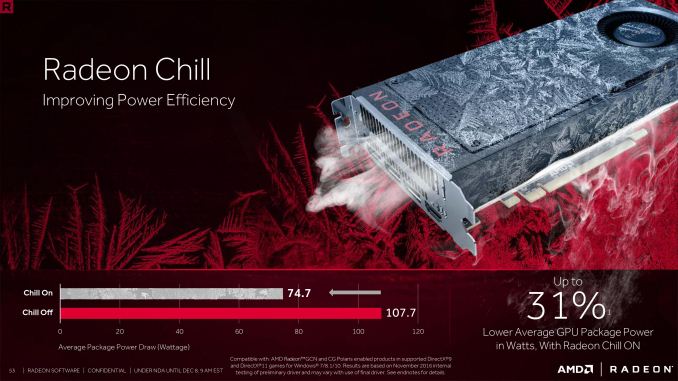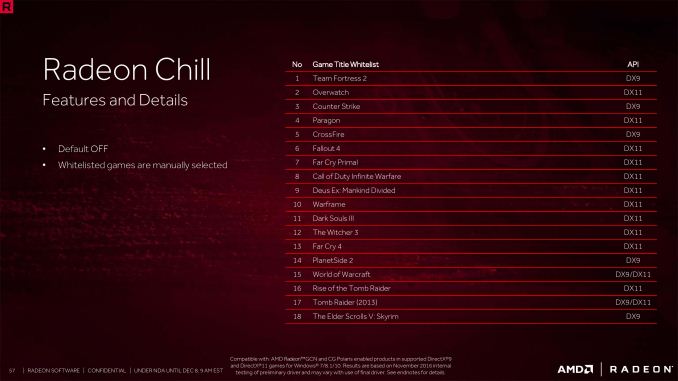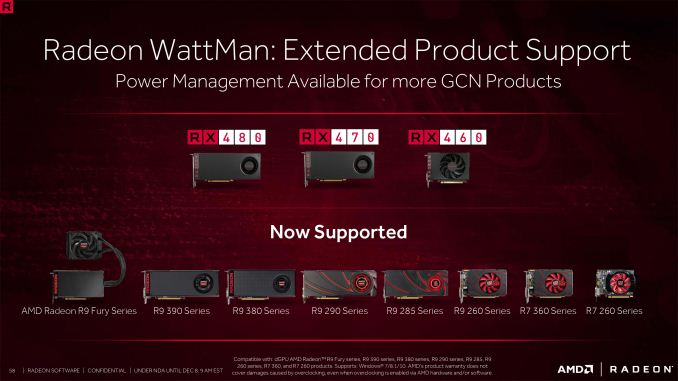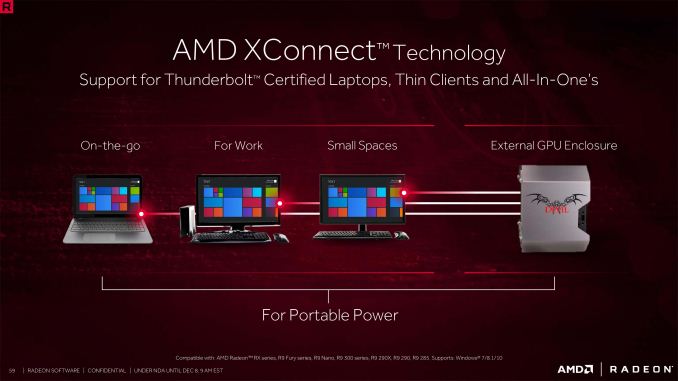AMD Delivers Crimson ReLive Drivers: Yearly Feature Update for Radeon Gamers and Professionals
by Ian Cutress on December 8, 2016 9:00 AM ESTReLive New Features (3)
Earlier this year, during the Polaris set of pre-briefings, AMD mentioned that it had acquired a company called HiAlgo. HiAlgo had designed a set of software and driver hooks to decrease FPS/power or increase response time by dynamically adjusting resolution by monitoring graphic workloads and gameplay mechanics. At the time the software only worked on DirectX 9, but since the purchase AMD is now bringing part of the package to its driver set. First up is CHILL.
Radeon CHILL
The concept of CHILL is fairly simple. During periods of low user interaction or little action on screen, the CPU and GPU power limit is reduced, causing the hardware to slow down. This reduces the frame rate during periods where a high frame rate is not required, allowing the CPU/GPU to cool down (where the CHILL bit comes in). This also saves power on power-limited systems such as laptops. When CHILL detects more action or more strenuous movement by the user, the power limit is moved back up.
We still need to test the software internally, but the idea means lower temperatures and lower average power consumption. One side-effect of this means that fewer frames are queued in the buffer, which AMD claims it results in a quicker response time from frame generation to frame output.
CHILL will be enabled in ReLive for any GCN enabled product, initially for only specific DX9 and DX11 titles. As a first release of CHILL, AMD is being somewhat cautious and shipping with the feature turned off by default and relying on a list of approved games at this time. We were told that as time goes on it may be turned on by default and games known to be incompatible will be denied by the software.
WattMan: Extended to More Cards
One of the big updates for the release of AMD’s Polaris GPUs was the WattMan (what, man?) power management software, taking over from previous overclocking tools.
As part of ReLive a number of 200 and 300-series discrete GPUs will now be enabled with WattMan as well as the R9 Fury series.
AMD XConnect Technology
During the gamut of external GPU enclosure announcements around Thunderbolt 3 during the year, AMD’s XConnect technology emerged as a leading figure. However, up until now, it mainly requires specific driver sets under specific hardware configurations.
With ReLive this is opened with XConnect now supporting any Thunderbolt certified laptop, thin client and all-in-one when used with an enclosure that supports an AMD Radeon discrete card with GCN 1.2 or above.














48 Comments
View All Comments
psychobriggsy - Friday, December 9, 2016 - link
AMD has been shipping proprietary AMDPRO drivers on Linux for quite some time, and if you want open source then AMD is the only choice really given Nvidia won't provide Pascal firmware images for Nouveau, and even then the AMD open source drivers are faster (in fact they compete very well with AMD's blobs on Linux now, they just don't provide OpenCL and Vulkan yet).Sure, if you game on Linux the Nvidia blobs are a bit faster than AMD overall, but it certainly isn't like a few years ago.
BrokenCrayons - Thursday, December 8, 2016 - link
Phrononix is my usual source for GPU benchmarks in Linux. I'm a regular reader over there and much of my current opinion was based on their performance analysis.YukaKun - Friday, December 9, 2016 - link
Benchmarks don't tell the day-to-day story. I have used both throughout the years and AMD has gotten ahead of the game now. People's complaints took some time, but they got their stuff together and they have zero things to have envy of nVidia's drivers.Performance not-withstanding, AMD is in a great shape now in the Linux world. In fact, I have to say it works wonders with SteamOS. Maybe I am a lucky one, but my 7970Ghz did not have a single issue playing all of the Linux ported titles and now the RX480 doesn't either. Outside of gaming, no issues either. It's been quiet sailing so far and I hope it remains that way.
I can't say the same thing with nVidia in my laptop. I still, after 10 years aprox, still don't have switchable graphics and I am scared of upgrading the proprietary binary, since I've had issues with it, even using genkernel.
Cheers!
BrokenCrayons - Friday, December 9, 2016 - link
Thanks for the information. I've been running a few older Nvidia GPUs (NVS 160m and 8400m GS) in my laptops without problems, but I don't use open source drivers. They experience has been very "sane" for my usage. I've yet to move my desktop with its GT 730 off Windows 7 which is largely a laziness thing as I already have an unused drive sitting in the case that just needs to be plugged in.I haven't personally tinkered with AMD graphics under Linux since I retired a couple of older laptops, one with a C-70 and another with an E-450 and their integrated GPUs. They were a pain to get working under Arch and Mint. I'm glad to hear that a current gen RX480 is working out for you. I might grab a RX460 in the next month or three and at that point I'll probably be more interested in transitioning to Linux and moving the system into a smaller case (microATX board in a full tower case...kinda a waste of space).
mr_tawan - Friday, December 9, 2016 - link
Bad news is, the latest AMD's RFC for DAL/DC get slammed today.psychobriggsy - Friday, December 9, 2016 - link
Yeah, I definitely sense that AMD's Linux devs were being held back by a higher up PHB regarding the HAL that was being imposed. Hopefully this major burn will allow them to do things properly at the kernel level even if it needs some linux-specific stuff in the drivers.IntoGraphics - Tuesday, January 3, 2017 - link
No.Read Phoronix for "It Looks Like AMDGPU DC (DAL) Will Not Be Accepted In The Linux Kernel" :
http://www.phoronix.com/scan.php?page=news_item&am...
VisS - Friday, December 9, 2016 - link
What Crap ?Colin1497 - Thursday, December 8, 2016 - link
Out of the box this looks really impressive. Time to start the download.One question: Technical reason that rebadged r9-2xx series cards get HDR10 in their r9-3xx guise while the original r9-2xx's don't? BIOS or marketing?
Colin1497 - Thursday, December 8, 2016 - link
Just realized how old I sound saying "start the download" like this was 1993 and it was going to take a week. It took a few seconds...